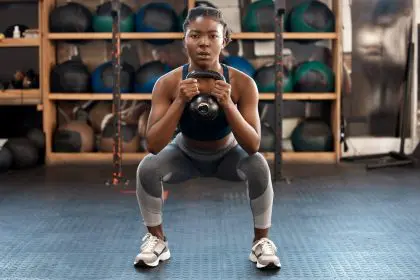For many people, the thought of beginning a fitness journey feels overwhelming. Between busy schedules, uncertainty about proper techniques, and concerns about injury, the barriers to starting exercise can seem insurmountable. However, recent research points to a surprisingly accessible approach that’s changing how we think about fitness for beginners.
Eccentric exercise—a method focusing on the lengthening phase of muscle movements—has emerged as a particularly effective strategy for those new to fitness. A recent study published in the European Journal of Applied Physiology revealed that previously inactive individuals experienced substantial improvements in strength, endurance and flexibility after just four weeks of simple eccentric movements performed daily.
The findings offer hope for anyone who has struggled to establish a consistent exercise routine, suggesting that meaningful progress doesn’t require hours in the gym or specialized equipment. Instead, just a few minutes of targeted movements each day can yield remarkable results.
Understanding eccentric movements
Eccentric exercise focuses on the “negative” or lengthening phase of any movement—the portion where the muscle extends rather than contracts. This approach emphasizes slowing down during this phase, creating tension in the muscle as it lengthens under control.
In practical terms, this means focusing on the lowering portion of movements. During a push-up, for example, the eccentric phase occurs when you slowly lower your body toward the floor. With a squat, it’s the controlled descent rather than the standing portion that constitutes the eccentric component.
What makes this approach particularly valuable for beginners is its accessibility and efficiency. Eccentric movements typically require less energy expenditure than their concentric (muscle-shortening) counterparts while potentially stimulating greater strength adaptations. This creates an ideal entry point for those who may have limited exercise tolerance or experience.
Research indicates that eccentric training can lead to greater gains in muscle size and strength compared to traditional approaches, particularly among those who are deconditioned. Perhaps most importantly for beginners, these exercises tend to cause less cardiovascular strain and fatigue, making them more sustainable for those just starting out.
The science behind the benefits
The recent study involved sedentary adults between ages 32 and 69, with women comprising the majority of participants. After establishing baseline measurements during a two-week control period, participants began a four-week eccentric exercise program that required minimal time commitment.
The daily routine consisted of simple movements that mimic everyday activities: chair squats (simulating sitting and standing), chair reclines (leaning back against a wall), wall push-ups, and heel drops. The key instruction was to hold for five seconds during the lowering phase and just one second during the raising phase—emphasizing the eccentric component.
These exercises were selected specifically for their practicality and relevance to daily life, ensuring that improvements would translate to functional benefits. Once participants could complete two consecutive sessions without difficulty, they progressed to slightly more challenging variations.
Researchers tracked various health metrics throughout the study, including cardiovascular markers, body composition measurements, strength assessments, and psychological well-being indicators. After the four-week intervention, participants demonstrated significant improvements in multiple fitness parameters.
While body composition and resting heart rate remained relatively unchanged—unsurprising given the brief intervention period—participants showed marked improvements in muscular endurance (measured through sit-up and push-up tests), cardiovascular fitness (assessed via step tests), flexibility, and perhaps most notably, mental health scores.
These outcomes suggest that even modest amounts of daily eccentric exercise can produce meaningful changes in physical function and psychological well-being for previously inactive individuals.
Why eccentric exercise works particularly well for beginners
Several characteristics make eccentric training especially suitable for those new to exercise. First, these movements primarily utilize body weight as resistance, eliminating the need for gym equipment or special facilities. This accessibility means exercises can be performed virtually anywhere, removing a common barrier to consistent physical activity.
Second, eccentric movements typically generate greater force with less energy expenditure compared to concentric actions. This efficiency allows beginners to stimulate muscle development without quickly becoming fatigued, enabling longer practice sessions and potentially greater adaptation over time.
Third, the controlled nature of eccentric exercise may reduce injury risk when performed correctly. By emphasizing slow, deliberate movements rather than explosive actions, beginners can develop proper form and body awareness before progressing to more dynamic exercises.
Perhaps most importantly, eccentric training appears to yield results quickly. The study participants experienced noticeable improvements after just four weeks of simple daily exercises—a crucial factor for beginners who might otherwise become discouraged without visible progress.
Getting started with your own eccentric routine
Implementing an eccentric-focused exercise routine requires no special equipment or extensive time commitment. The following exercises serve as an excellent starting point for beginners:
Chair squats: Stand in front of a sturdy chair with feet shoulder-width apart. Slowly lower yourself toward the seated position over five seconds, barely touching the chair before standing up in one second. Begin with your hands extended forward for balance, eventually progressing to crossing them over your chest as strength improves.
Wall push-ups: Stand facing a wall with feet about two feet away. Place palms against the wall at shoulder height. Bend your elbows to bring your chest toward the wall over five seconds, then push back to the starting position in one second. As you build strength, increase the challenge by placing your feet farther from the wall.
Chair reclines: Stand with your back against a wall, feet about two feet away. Slowly slide down the wall for five seconds until your knees reach approximately 90 degrees, then return to standing in one second. This exercise targets the quadriceps while providing back support.
Heel drops: Stand on the edge of a step with heels hanging off. Rise onto your toes, then very slowly lower your heels below the level of the step over five seconds before rising again in one second. Hold a railing or wall for balance as needed.
For each exercise, aim to complete at least 10 repetitions daily. The entire routine should take less than five minutes to complete, making it feasible to incorporate into even the busiest schedule. As these movements become easier, progress by increasing the number of repetitions, adding additional sets, or trying more challenging variations.
Building sustainable habits
While the research demonstrates that five minutes of daily eccentric exercise can produce meaningful results, it’s worth considering how to build upon this foundation as your fitness improves. Health organizations generally recommend working toward approximately 150 minutes of moderate physical activity weekly for optimal health benefits.
The key to sustainable progress lies in gradual progression. Begin with the five-minute daily eccentric routine, focusing on proper form and consistent practice. As this becomes comfortable, consider adding a few minutes of additional activity each week. This might include brisk walking, gentle cycling, or swimming—activities that complement the strength benefits of eccentric training with cardiovascular improvements.
Pay attention to how your body responds, adjusting intensity and duration based on your energy levels and recovery capacity. Remember that consistency matters more than intensity, particularly in the early stages of a fitness journey. A modest routine performed regularly will yield greater benefits than occasional intense sessions followed by lengthy periods of inactivity.
Track your progress using simple metrics like the number of repetitions completed, perceived exertion levels, or improvements in everyday activities like climbing stairs or carrying groceries. These tangible signs of progress can provide powerful motivation to continue.
Beyond physical benefits
While strength and endurance improvements represent valuable outcomes from eccentric exercise, the psychological benefits warrant equal attention. The study participants reported enhanced mental well-being after completing the four-week program, highlighting the powerful connection between physical activity and emotional health.
This psychological boost likely stems from multiple factors. Exercise stimulates the release of endorphins, natural mood elevators that can reduce stress and anxiety. Additionally, mastering new skills and witnessing physical improvements fosters a sense of accomplishment and self-efficacy that can translate to other life domains.
For many beginners, perhaps the most significant psychological benefit comes from overcoming the initial barrier to starting. By proving that they can successfully incorporate exercise into their lives—even in small amounts—individuals often experience a paradigm shift in how they view themselves and their capabilities.
This shifting self-perception can spark a positive feedback loop: exercise improves mood and confidence, which increases motivation to continue exercising, which further enhances mental well-being. This virtuous cycle helps explain why even modest amounts of physical activity can lead to profound life changes over time.
The takeaway for fitness newcomers
The emerging research on eccentric exercise offers an empowering message for those hesitant to begin a fitness journey: meaningful progress doesn’t require intense workouts or significant time investments. By focusing on quality movements performed consistently, even five minutes daily can yield noticeable improvements in strength, flexibility, and overall function.
This approach removes many common barriers to exercise, making fitness accessible to virtually anyone regardless of current condition, available time, or access to facilities. The simplicity of these movements, coupled with their relevance to everyday activities, creates a practical entry point to physical activity that can evolve naturally as fitness improves.
For those who have previously struggled with exercise adherence, eccentric training offers a fresh perspective—one that emphasizes efficiency over volume and accessibility over intensity. This paradigm shift may prove particularly valuable in helping more people discover the transformative benefits of regular physical activity.
Whether you’re completely new to exercise or returning after a long hiatus, eccentric movements provide a gentle yet effective pathway toward improved fitness. Start with just five minutes daily, focus on proper form rather than intensity, and trust that these modest efforts will accumulate into meaningful progress over time.
Remember that the journey toward better health begins not with dramatic changes but with small, sustainable actions performed consistently. In fitness, as in life, the most profound transformations often start with the smallest steps.
















